2015 was a wild, fun and successful ride self-publishing for me, but I haven’t (yet) published any books on Amazon this year.
The reason for this is I’ve been focused on other projects and campaigns for too long, such as publishing our digital magazine, starting my social media consulting firm and acquiring users, and growing OpenWorld Magazine’s Instagram to its first 20,000 followers.
Moreover, my current books have gone from earning $2,000+ in a week at the end of 2015 to just a paltry $86 all of last month.
If I were a parent any competent authority would take my books away for gross neglect. To finally fix this I purchased my friend Dave Chesson’s new software app, KDP Rocket, to help me position my books better for long-term success success and sales.
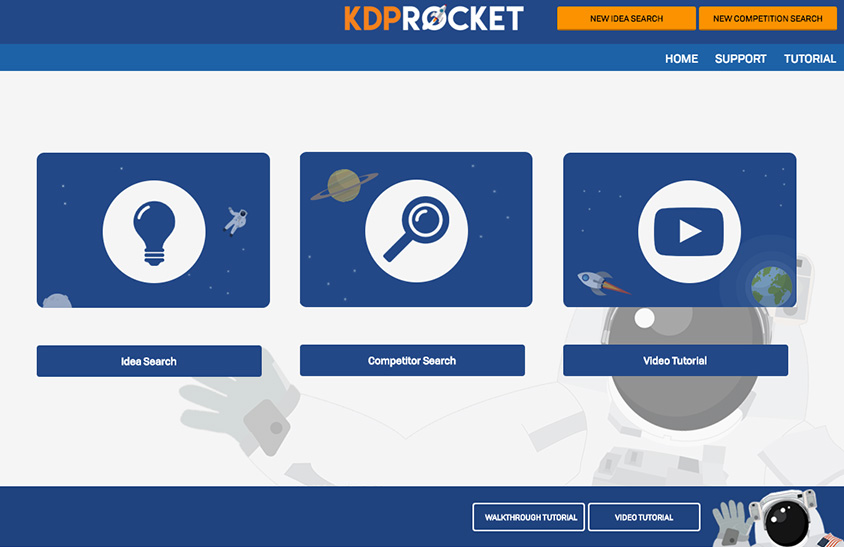
Keyword research is something I’ve loathed for as long as I can remember. It doesn’t mesh well with my personality; I’m a creative type, not an analyst. Spreadsheets put me to sleep.
So it was with reluctance that I dragged myself into finally doing the research needed to improve my keyword optimization and search placement.
Fortunately, KDP Rocket’s interface is super easy to get into and use, and Dave has written many great articles on Kindlepreneur to get one up to speed. And after a day or two of researching and brainstorming keyword ideas, it almost became kind of fun.
It was the familiar sense of fun that comes from the feeling of making progress, and the hope that better results await tomorrow filled me with optimism and enthusiasm.
Now that I’ve finished this process and updated all of my books, I’ve begun to see the results immediately. In this article, I’m going to share with you the process I used and walk you through my exact workflow. If you feel your books are not optimized to perform as well as they should be, you may want to get out a pen and take notes.
Indeed, almost every book can be improved upon in some fashion, and there are a great number of books on Amazon which aren’t optimized AT ALL. This presents an opportunity for those willing to put in a bit of extra effort.
In this post I’ll provide a number of action steps to help your book perform the best that it possibly can.
Sound good?

Preliminary Step – Assemble Your Keywords
Day one: Getting started is easy enough. Begin by listing out potential keyword and keyword phrases that describe your book to research.
If your book is already published, you can go into KDP, check your book details, and see what keywords you added when you submitted your book. This is a great place to start. Or simply think of 4-5 keywords that someone might search for to discover your book.
Once you have these, begin to look for variations. You can do this by visiting Amazon.com, selecting “Kindle Store” in the search bar, typing your keyword into the box and seeing what the autofill suggests.
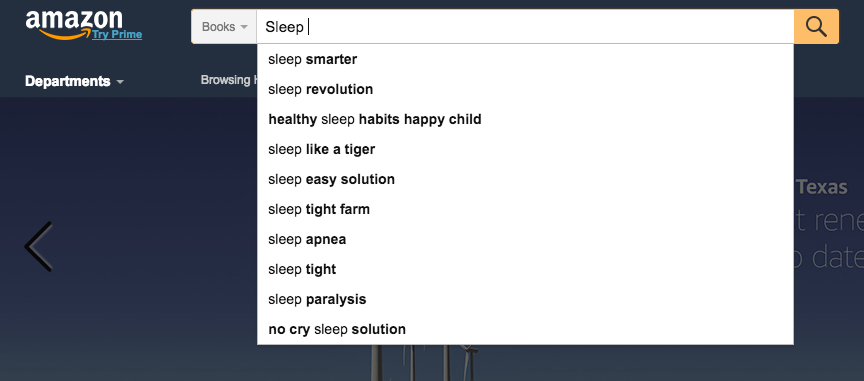
So, for my book “Hack Sleep” I might type “sleep” or “insomnia” into the search bar, then a space, and see what phrases pop up. Take note of these and add them to your list.
Continue researching using the autofill. Type each letter of the alphabet after your keyword, “a, b, c,” and so on until you’ve seen all the potential variations, and add the ones that look interesting to your list.
That’s it! You’re done. You’ll probably come up with at least 30 phrases this way, and perhaps 10-12 will be highly relevant.
Once I have my list of keywords, I break my workflow down into three steps…
- Select two secret keywords.
- Select five more keywords to round out the seven.
- Optimize the book page.
1) Select two “secret keywords.”
Most people don’t know about these, which means they can get you ranked in categories that other authors don’t even know exist. You can find these here.
You may find that these secret keywords are tough to apply to your book, as I did. The good news is that 99% will probably not apply to your book in any sense at all. So if you eliminate those, it shouldn’t be hard to find two that sorta, kinda work.
For example when I tried to add secret keywords for “Hack Upwork” I saw nothing remotely related to working from home or freelancing, so I chose “business” and “innovation.”
Then something caught my eye, and I noticed a category called “Business & Money/Biographies & Primers/Inspiration” with the secret keyword “inspiration.” In the end I gauged this category to be less competitive than one focused on technological innovation, so I changed my keyword from “innovation” to “inspiration.”
Fortunately for me, I had many more secret keyword options to pick from for my flagship book, “Buy Your Own Island.” Business and Money, Travel, and Health/Fitness/Dieting were three parent categories that could all equally apply in some way.
Searching the “Travel” category one keyword stuck out in particular: “solo_travel” (the keyword has to be written exactly that way to rank for this category – including the underscore!)
Researching the category on Amazon, this is what I saw:
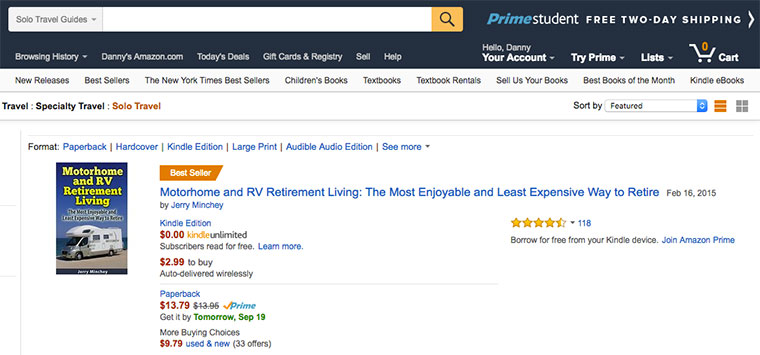
Boom! Bingo… a book with a very-poorly designed cover ranking at the top.
I gauged that I have a good chance to knock this book off and become #1 in this category. I still have to beat this RV book in terms of sales, which could be a challenge, but if I play my cards right, run a couple of promotions and drop my price down from $9.99 to say, 0.99 or 2.99, it’s definitely doable.
2) Select five more keywords to round out the seven.
This is the point when we start taking the list of keyword phrases we’ve gathered and plug them into KDP Rocket. For each book, I’d choose several I was most keen on, clicked “Idea Search” in the software, and looked at the stats.

This is where the software really shines. It makes the research ridiculously easy. The software shows both estimated monthly Amazon search volume AND Google search volume simultaneously. It also calculates the average revenue of each book based on its ABSR (though this can be misrepresented from time to time – see the reason below).
One issue I ran into as I researched phrases was that free books were often included in the results. For example, when I searched “Freelance” the very first title was a free book.
Comparing books during a free promotion to paid ones is apples to oranges and not at all relevant to what we’re doing here. A book that’s temporarily ranking #1 during a free promotion may not be making any money at all.
We’re looking for sales.
Currently, there’s no way to filter out free books from the results. Trying to sort results by pricing from “High to Low” skews the results and doesn’t present you with the best-sellers. The only way to avoid the free books is to check whether it says “$0.00 Kindle Edition” next to the title.
Equally frustrating, KDP Rocket looks at the average of the five books currently ranking at the top of a keyword search to calculate monthly earnings – so if there’s two or three (or five) books priced at 0.00 it will throw off the estimate of average monthly earnings.
When I searched “work online” all five of the top books were priced at 0.00. So this metric was not a reliable indicator of how profitable a keyword phrase was. I took this metric with a grain of salt, prioritizing raw Amazon search volume first and foremost.
Another frustration you might experience as you go through this process (as I did) is that you may update your seven search keywords within KDP and be tempted to “Save” your progress.
Reasonable enough, right?
The problem is that once you hit “Save” your changes will take more than half a day to be reviewed and updated – and during that time you won’t be able to update your book title, description, cover, etc.
So do not submit your book updates for review until you’ve completed everything. The good news is you can keep the KDP window open as long as you like without every logging out and can even edit certain parts (such as keywords and description) offline.
3) Optimize the book sales page.
After updating my seven keywords, I began to look for places where I could insert these keywords naturally in my book page. The book description was the first obvious (and easiest) place to look. Small changes was all it took; for example I’d replace “sleep issues” with “sleep disorders” to match a target keyword.
As I researched top ranked books in the niches I was considering, I began to take note of several other techniques to improve my book page, based on what I saw the most successful books doing.
Here’s my checklist for optimizing the book page:
• Add editorial reviews if you don’t have them yet. This can be done easily enough in Amazon Author Central. If you only have a few, add more.
• Use bold lettering in both your book description AND in your editorial reviews to make certain statements pop (incidentally you can also bolden some of your keywords to give them greater importance).
• Add MASSIVE social proof to your “More About the Author” section. Throw in every feature, every association, every degree and qualification that you’ve ever achieved in your lifetime.
• Consider adding a #1 best-seller sticker to your cover. All of my books reached #1 best-seller when they launched, and this certainly couldn’t hurt.
• One interesting tactic that I spotted was a book actually deliberately adding keywords at the end of the book description as “tags.” Since this book was ranking relatively well and had a top 15,000 ABSR, it certainly couldn’t hurt to try.
• Almost all of the books I saw ranking at the top for keywords were using Heading tags (h1 and
h2 formatting). These help show the search engine what terms you should rank for.
• Listing the actual contents of the book in the description (chapter titles, sub-chapters, etc) in the form of bullets. I saw one book doing this in H2 formatting which looked pretty tacky, so I don’t recommend doing that. But listing the contents, especially if they are keyword-loaded, could only help (it helps both potential readers and Amazon’s search engine know what your book is about). Inside the description you will find no button to add bullets, but you can add them easily enough on your own by pressing ALT+8 on your keyboard.
• As for how to write the content of your book description to sell more books, I recommend the “AIDA” formula laid out in this post.
Lastly, I polished up my book covers, you can see some before and after pics:

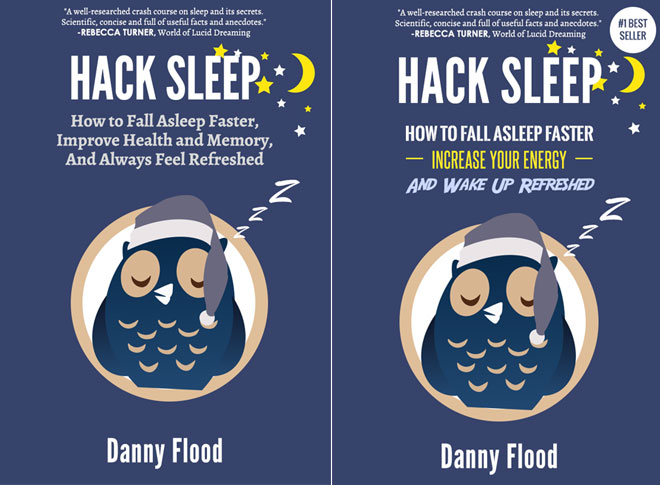
Book covers: before and after for “Hack Your Mind” and “Hack Sleep.”
Basically, I made the typography more exciting by replacing the sub-titles adventurous designer fonts. With “Hack Sleep” I also made the title and sub-title about 110% bigger, to make it pop more and stand out at thumbnail size.
Finally, I changed the file name of my book cover file to include a couple of my keywords. For instance, I renamed the “Hack Sleep” from “hack-sleep-cover.jpg” to “Sleep Help – Sleep Better and Sleep Well.jpg.”

Results
Kindle updated its rankings almost immediately after I’d finished. As I checked my books the next day, I noticed that I was ranking on Page 1 for many of my selected keyword phrases, though not at the top #1 spot for most of them.
Still, it’s a promising start.
One nice thing about this whole process is that it is easy to open the KDP panel, review your seven keywords for each book and check in the Kindle store to see how well you are ranking.
Over the next few weeks I will spend more time optimizing each book page to increase their position for each keyword, and decide which keywords are worth keeping and which ones to change.
Looking ahead, I’m planning to do more work to optimize the pages better to increase my keyword density and “click to buy” ratio. The click to buy ratio is the ratio of Kindle shoppers who click on your book within the results and make a purchase. A higher percentage means Amazon will boost your book higher so that you (and they) make more sales.
One way I’m hoping to improve my conversion rate is by purchasing a gig through BookRazor. This past weekend BookRazor delivered me a list of Amazon readers who have reviewed titles similar to my own, including “Top 500” and “Vine Voice” reviewers. Over the next week I’ll be reaching out to send free copies of my book “Buy Your Own Island” in exchange for reviews.
From what I’ve observed, credible reviews from top ranked Amazon reviewers DO seem to provide a significant boost to any book. Though I’m not entirely sure if Amazon factors them into its algorithm, or if it merely provides a credibility boost to potential buyers (or both).
== UPDATE: I’m also pleased to say that I’ve just received my first Top 1,000 Review for “Hack Sleep!” ==
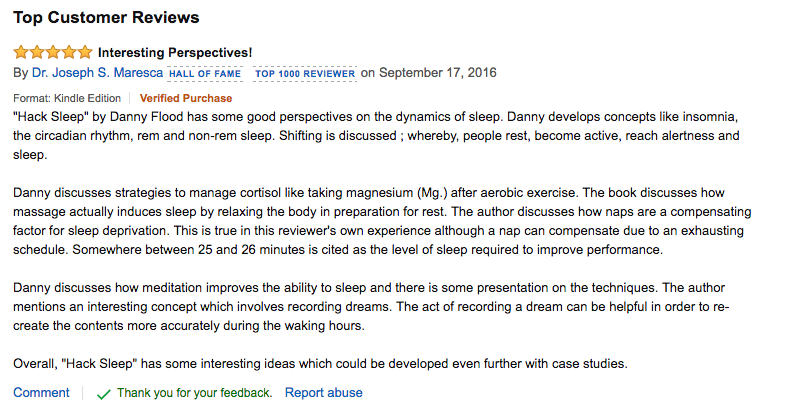
Getting this was simple enough. Book Razor sent me a spreadsheet of reviewers, their names, and e-mail addresses. I then imported these into Streak for Gmail and sent out a “Mail Merge:” automated customized mass e-mail.
All in all, I’m pleased with my purchase of KDP rocket and its ease of use. I highly recommended checking it out if you’re thinking about self-publishing a book. I also prefer the interface more than Google Adword Planner, and as KDP Rocket provides Google search volume, I’ll use it for traditional SEO research as well.
Hope you enjoyed this post and learn something from my experience. If you’re looking for more, Dave has written some very extensive articles on his blog. There you’ll learn everything else you need to know to optimize your books for Kindle’s search engine.



